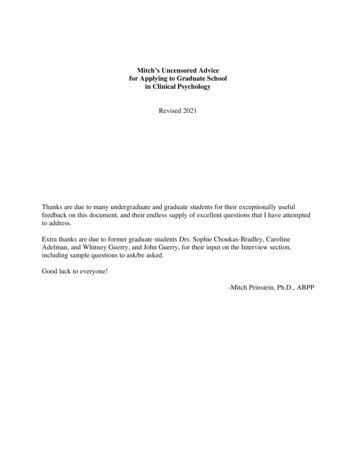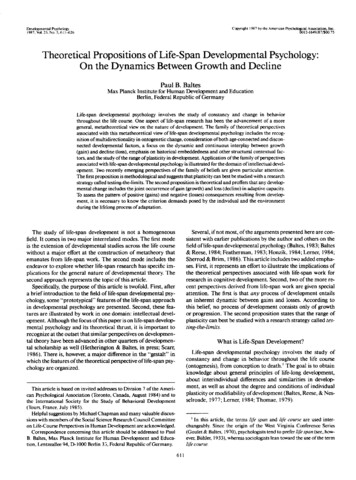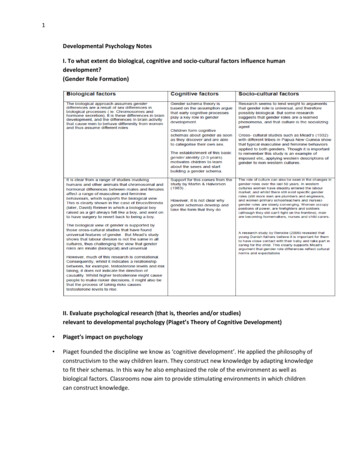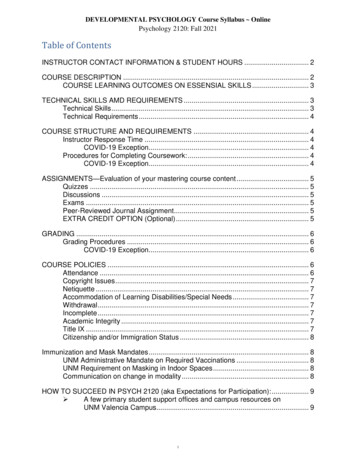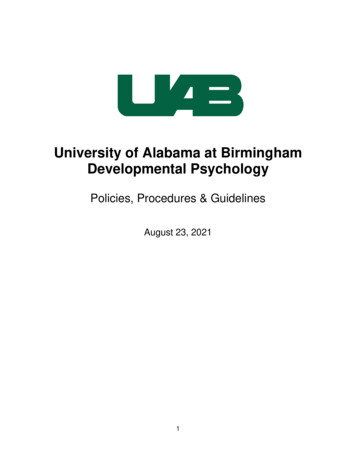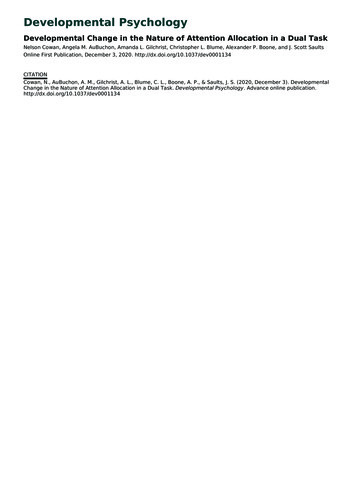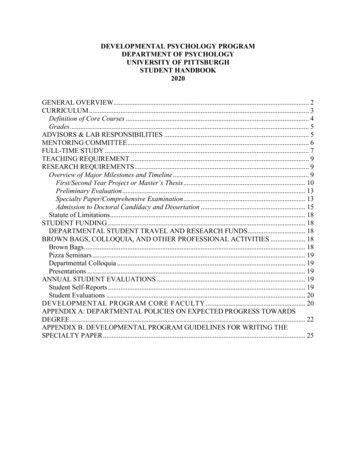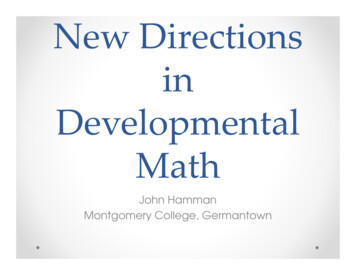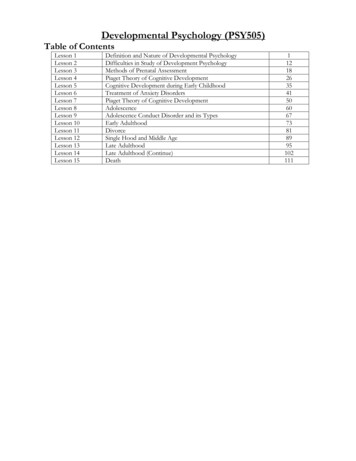
Transcription
Developmental Psychology (PSY505)Table of ContentsLesson 1Lesson 2Lesson 3Lesson 4Lesson 5Lesson 6Lesson 7Lesson 8Lesson 9Lesson 10Lesson 11Lesson 12Lesson 13Lesson 14Lesson 15Definition and Nature of Developmental PsychologyDifficulties in Study of Development PsychologyMethods of Prenatal AssessmentPiaget Theory of Cognitive DevelopmentCognitive Development during Early ChildhoodTreatment of Anxiety DisordersPiaget Theory of Cognitive DevelopmentAdolescenceAdolescence Conduct Disorder and its TypesEarly AdulthoodDivorceSingle Hood and Middle AgeLate AdulthoodLate Adulthood (Continue)Death1121826354150606773818995102111
Developmental Psychology (PSY505)VULesson 0 1DEFINITION AND NATURE OF DEVELOPMENTAL PSYCHOLOGYDevelopmental Psychology is one of the sub-fields of Psychology. It is an ontogenetic study ofhuman organism from conception to death. Developmental Psychology seeks understanding andcontrols the basic processes and dynamics underlying human behavior at the various stages oflife. Its investigations encompass the growth and maturation of the individual organism, itscognitive and emotional powers, as well as its personality structure.Developmental Psychology, as a science of growth, deals with all the processes contributing tobecoming an infant, a child, an adolescent, and a mature adult.According to Hurlock, "Developmental Psychology is the branch of psychology that studiesintraindividual changes and interindividual changes within these intraindividual changes. Its taskis not only description but also explication of age-related changes in behaviour in terms ofantecedent consequent relationship."Some developmental psychologists study developmental changes covering the life span fromconception to death. Others cover only a segment of the life span, childhood or old age.Developmental Psychology is a scientific discipline that attempts: (I) to devise methods forstudying organisms as they evolve over time ( U ) to collect facts about individuals of differentages, backgrounds and personalities and (iii) to construct a theoretical frame work that canaccount for the observed behaviors as well as for the changes occurring throughout the lifecycle.ASPECTS OF DEVELOPMENTThere are four aspects of development which are closely intertwined. Each aspect ofdevelopment affects the other1.Physical development2.Intellectual development3.Personality development4.Social developmentWe will now discuss each of these in brief.1. Physical development. Physical development consists of changes in the body, brain, sensorycapacities and motor skills. They exert major influences on both intellect and personality.For example, much of an infant's knowledge comes from the senses and from motor activity.A child who has a hearing loss is at risk of delayed language development. In late adulthood,physical changes in the brain as in Alzheimer's disease - which has been estimated to affectabout 10 percent of people over the age of 65 (Evans et aL 1989) can result in intellectualand personality deterioration.2. Intellectual development, Changes in mental abilities - such as learning, memory, reasoning,thinking and language are aspects of intellectual development. These changes are closelyrelated to both motor and emotional development. A baby's growing memory, for example, Copyright Virtual University of Pakistan1
Developmental Psychology (PSY505)VUis related to separation anxiety, the fear that the mother will not return once she has goneaway. If children could not remember the past and anticipate the future, they could notworry about the mother's absence.Memory also affects babies’ physical actions. For example, a one-year old boy whoremembers being scolded for knocking down his sister's block tower may refrain from doingit again.3.And 4 personally and Social development. Personality and social development affect withthe cognitive aspects and the physical aspects of functioning. For example, anxiety abouttaking a test can impair performance; and social support from friends helps people copewith the negative effects of stress on their physical and mental health.PRINCIPLES OF DEVELOPMENTDevelopment follows certain principles. These principles wasimilarpatternofdevelopment, with one stage leading to next.For instance, they baby stands before he walks, or draws a circle before a square.(ii) alsdevelopmentdevelopmentdif-fer, all children of the same age to do not reach the same point of llydifferentratesoforphysicaldeclinehave likewise been observed for different physical and mental traits.(iii) Development is continuous: From the moment of conception to the time of death,changes re taking place within the individual, sometimes slowly. As a result, what happens atone stage of development varies over and influences the following stages. Unhealthyattitudes developed in childhood, for example, have been found to be at the root of muchof the unhappiness and poor adjustment during middle and old age.(iv) Development Proceeds from General to Specific Responses: In mental as well as motorresponses, general activity always precedes specific activity. For example, the baby waveshis arms in general movements before he is capable of a specific a response as reaching.Studies of speech have revealed that the young child learns general words before he learnsto call each toy by its name.(v) All Individuals are Different: Although all individuals follow a definite and predictablepattern of development each individual has his own distinct style of doing so. Some developin a smooth, gradual, step by-step fashion, while others move in spurts. Some show wide Copyright Virtual University of Pakistan2
Developmental Psychology (PSY505)VUswings, while others show only slight ones. Individual differences are due partly todifferences in hereditary endowment and partly to environmental influences. There arefewer differences in physical structure than in intellectual differences. Difference in specialaptitudes seems to be the most mark of all.(vi) Direction of Physical Development: Physical development follows two laws:(a) Cephalocaudal Principle. This means that improvements in structure as well as in control ofdifferent areas of the body come first in the head region, then in the trunk, and last, in theleg region. No only do the structures in the head region develop sooner than those in the legregion, but not or control comes first in the upper areas of the body and last in the lowerareas.(b) Proximodistal Principle. According to this principle, development proceeds from near tofar-outward, from the central axis of the body toward the extremities. Head and trunkdevelop before the limbs. Arms develop before the fingers. Functionally, the baby can movehis hands as unit before he can control the movement of his fingers.(vii) Each Stage has characteristic Traits. Our life nce, adulthood and old age. Each of these stagescertain problems of adjustment.is divided into achildhood,adolesis characterized by(viii) traitsare developed in two ways, partly from intrinsic maturing of these idual.Development through intrinsic maturity is known as Maturation and development through one's experience and exercise is termed Learning.(ix)Development follows a Familiar and Predictable Pattern. There is a particular pattern ofdevelopment for each species, animal or human. Development follows a regular geneticsequence during the prenatal period, in progressive stages. Similarly, the postnatal periodalso witnesses an organized development, although facts develop more quickly than memoryfor abstract or theoretical thinking. Cases of incompatibility in the rate of development ofdifferent physical and mental traits, lead to problems in adjustment. If the intellectualdevelopment exceeds or outpaces the physical, emotional or social development the childwill be out of step, with his contemporaries or even other children.(x) The global of all development is self-realization:In general, the overall goal or objective of individual development is self-realization which isdefined as the motive to achieve one's potential. It is difficult to define what maturity is. Aperson who has attained physical maturity may still want in intellectual maturity with a stilllonger way to go to reach social or emotional maturity. Further, the level of maturity for oneperson may not be applicable to the other. Each person is endowed with certain growthpotentials which can be developed to maximum level for that individual, given a favorableenvironment. Copyright Virtual University of Pakistan3
Developmental Psychology (PSY505)VUArnold Gessel has identified the following important principles of development.1. The Cephalo-caudal Principle. In general, structures in and around the head area developfirst, and structures in and around the tail area develop last.2. The Proximodistal Principle. In general, the brain and nervous system and the internalorgans develop earlier than the extremities and the physiological systems associated withthem.3. The Differentiation Principle. In general, the development of a new organ or subsystembegins with its growth as a relatively undifferentiated mass which nevertheless is identifiableas a separate part of the organism, and then, once this mass has grown, it differentiates intofiner and more interrelated subparts.4. The Bilateral Principle. Humans have bilaterally organized bodies, with many partsappearing in pairs, one on each side. During development, each number of a given pair ofparts appears at about the same time and develops at about the same rate as thecorresponding member of the pair.DEFINITION OF GROWTH AND DEVELOPMENTThe terms growth and development are often synonymously used in daily language. But notso in Psychology.Before we begin our discussion, therefore, we would carefully note the meanings of theterms "growth" and "development". The term "growth" refers more to the physical growthgrowth from the fertilized egg at time of conception to the fully grown body of the adult,that is, growth means increases in the size of the various parts of the body. The term"development" refers to the progressive changes that take place with time in the behaviourof the organism and which lead to maturity. Through separate, growth and development aresimultaneous processes. They are also inter depended in the same that stunning of growthmay often, though not always, result in deficits of development and vice-versa.DISTINCTION BETWEEN GROWTH AND DEVELOPMENTThe two main pints of difference between growth and development are as follows:(a) Growth denotes the structural and physical changes within the body of the individual rightfrom the moment of conception to the adult period. Development refers to growth and thescope of physical and mental progress a person is capable of achieving.(b) Growth denotes quantitative changes, it shows an increase in the size and structure of thebody and organs. Development refers to changes which are qualitative and directional. Thechanges are improvement and move forward rather than backward. Copyright Virtual University of Pakistan4
Developmental Psychology (PSY505)VUAlong with the concept of growth and development, we must also understand the meanings oftwo other concepts which play an important role in human development. The first one ismaturation and the second one is learning.PERIODS OF THE SPANHuman development progresses through a series of various stages. The entire life span of humanbegins can be divided into eight periods. The divisions of the life span in these eight periods aresomewhat arbitrary especially in adulthood. We will discuss these eight stages or periods in ion.Duringthisstage,the following important developments take place:(i)Basic body structure and organs form(ii) Physical growth is most rapid in this period of the life span.(iii) Vulnerability to environmental influences is erizetothethisagestageofofdevelopment:(i)The new-born is dependent and competent(ii) All sense operate at birth(iii) Physical growth and development of motor skills are rapid.(iv) Ability to learn and remember is present, even in early weeks of life.(v) Attachments to parents and other form toward en of first year.(vi) Self-awareness develops in second year.(vii) Comprehension and speech develop rapidly(viii)3.Interest in other children increases.Early Childhood. This period of development ranges from 3 to 6 years of life. Thefollowing important developments take place during this period:(i)Family is still the focus of life, although other children become more important.(ii) Strength and line and gross motor skills improve.(iii) Independence, self-control, and self-care, increase.(iv) Play, creativity and imagination become more elaborate.(v) Cognitive development leads to many 'Illogical' ideas about the world.(vi) rpeople'sperspective grows.4.Middle Childhood. This period ranges from 5 years to 12 years.The following important changes take place during this period: Copyright Virtual University of Pakistan5
Developmental Psychology (PSY505)VU(i) Peers assume central importance(ii) Children begin to think logically, although largely concretely.(iii) Egocentrism dimities.(iv) Memory and language skills increase(v) Cognitive gains improve the ability to benefit from formal schooling.(vi) Self-concept develops, affecting self-esteem(vii) Physical growth slows.(viii)5.Strength and athletic skills improveAdolescence. The period extends from the age of 12 to puberty to around 20 years. Thefollowing major developments take place during this period.(i) Physical changes are rapid and profound(ii) Reproductive maturity is attained(iii) Search for identity becomes central(iv) Ability to think abstractly and use scientific reasoning develops.(v) Adolescent egocentrism persists in some behaviors.(vi) Peer groups help to develop and test self-concept(vii) Relationships with parents are generally good.6.Young adulthood. This is period that ranges from 20 to 40 years. The following majordevelopments take place during this period.(i)Decisions are made about intimate relationships(ii) Most people marry; most become parents(iii) Physical heath peaks, then declines slightly(iv) Career choices are made(v) Sense of identity continues to develops(vi) Intellectual abilities assume new complexity.7.Middle age. This period ranges from the age of 40 years to 65 years.The following important developments take place during this period.(i) Search for meaning in life assumes central importance.(ii) Some deterioration of physical health, stamina, and prowess takes place.(iii) Women experience menopause(iv) Wisdom and practical problem-solving skills are high; ability to solvenovel problems declines.(v) Double responsibilities of caring for children and elderly parents maycause stress(vi) Time orientation changes to "time left to live". Copyright Virtual University of Pakistan6
Developmental Psychology (PSY505)(vii)VULaunching of children typically empty nest.(viii)Typically, women become more assertive, men more nurturant andexpressive.(ix) For some, career success and earning powers peak; for others "burnout" occurs.(x) For a minority, there is a mid-life "crisis".8. Late Adulthood. This is period ranging from 65 years of age and over.The following important changes take place during this period: (i) Most people hearty and active,although heath and physical abilities decline somewhat.(i)Most people are mentally alert. Although intelligence and memorydeteriorate somewhat, most people find ways compensate.(ii) Slowing of reaction time affects many aspects of functioning.(iii) Need to cope with losses in many areas (loss of one's own faculties,loss of loved once).(iv) Retirement from work force creates more leisure time by many reduceeconomic circumstances.(v) Need arises to find purposes in life to face impending death.RESEARCH METHODS IN THE STUDY OF HUMAN DEVELOPMENTThere are, broadly speaking, two methods of research in the study of human development. Thereare as follows: 1. None-experimental methods1.Case study method2.Naturalistic observation3.Laboratory observation4.Interview5.Co relational studiesII. Experimental methodsNon-experimental methods1. Case study method. Case studies are studies of a single case or individual. Much of the datafor psychoanalytical theories comes from case studies- careful notes and interpretations ofwhat patients have said under psychoanalysis.Our earliest sources of information about infants' development are case studies- carefulnotes and interpretation of what patients have said under psychoanalysis.Our earliest sources of information about infants' development are case studies called babybiographies, journals in which parents recorded children's day by-day development. Thefirst that we know about was begun in 1601; one of the most famous was Charles Darwin’s Copyright Virtual University of Pakistan7
Developmental Psychology (PSY505)VUabout his son; and perhaps the most influential were those of Jean Piaget, whose theoriesabout how children learn drew extensively on observations of his own three children.An important more recent case study is the poignant story of "Genie". Case studies offeruseful, in-depth information, giving a rich description of an individual. But these studieshave shortcomings.(i) Case study does not tell us about the exact cause-effect relationship.(ii) Furthermore case studies do not explain behaviour, and if they try to Case study can also beaffected by "observer bias". That is, the recorder may emphasize some aspects of a person'sdevelopment and minimize others. While case studies may tell a great deal about individuals,then, it is questionable how well the information applies to people in general.2.Naturalistic observation. In naturalistic observation, researchers observe and record people'sbehaviour in real-life settings. (Like pre-schools or nursing homes). They do not manipulatethe environment or later behaviour. To gain normative information, researchers observepeople;record data about their development at various ages; and derive aver- age ages, or norms, forgrowth and for the appearance of various skills and behaviors.One type of naturalistic observation is time sampling, a technique used to determine howoften a particular behaviour (like aggression, babbling or crying) occurs during a givenperiod of time. The method of naturalistic observation is of great use, especially in thosecases where normal human aspects of children's behaviour cannot be studies in laboratorysettings. They have to be studied as and when the behaviour occurs. In such cases,naturalistic observation methods are the best method.Observations studies have a number of drawbacks.(i) Observation studies cannot explain or determine cause and effect.(ii)The very presence of the observer can alter the behaviour being ceandalltherecordsubjectsbeinthe same basic situation and to yield information on the subjects’ behaviour in thisexperimental situation.Laboratory' observation has the greatest advantage of telling us about the exact cause andeffect relationship. It is one of the most scientific and reliable type of observation. Howeverits greatest disadvantages are as follows:(i)Problem of generalizabiIity. It is difficult to generalize with highdegree of accuracy, the finding obtained in laboratory settings to everyday lifesettings.(ii)Occurrence of demand characteristics and experimenter bias.(iii)Many important aspects of human behaviour cannot be studied in laboratory setupdue to ethical and moral reasons. Copyright Virtual University of Pakistan8
Developmental Psychology (PSY505)VU4. Interview. In an interview, researches ask questions about people's attitudes or opinions orsome other aspect of their lives. By interviewing a large number of people, investigators geta picture of what people say they believe or do or have done.A problem with interview is that the memory and accuracy of the interviews may be faulty.Some subjects forget when and how certain evens actually took place. Others distort theirreplies to make them more acceptable to the questioners or to themselves. Finally, thewording of a question can influence how people answer it.6. Co relational studies. Co relational means relationship between two variables. One methodof studying how two variables are related is to determine the correlationship between them.Let us explain this with the help of an example.Suppose that we want to determine the relationship between two factors; for example,between a parent’s intelligence and a child's language ability. By carefully measuring boththe factors (which are called variables, because they very among members of a group or canbe varied for purposes of an experiment) we might find that higher a parent's scores onintelligence test, the larger a child's vocabulary is at a given age. If so, we have found apositive correlation between the parent's intelligence and child's vocabulary.Correlational studies show the direction and magnitude of a relationship between variables.That is, they can tell us whether two variables are related positively (that is, both increasetogether and decrease together) or negatively (as one increases, the other decreases), and towhat degree. Correlation are reported as numbers ranging from - 1.00 (perfect negative, orinverse, or direct, relationship) to 1.0 ( a perfect positive, or direct, relationship). Thehigher the number whether or -), the stronger the relationship (either positive ornegative). A con-elation of zero shows that there is not relationship between the two variables. Knowing the correlation (or relationship) between variables. Knowing the correlation(or relationship (or relationship) between variables allows researchers to make predictionsabout development.However, Correlational studies do not give any information about cause and effect. Astrong positive correlation does not tell us they, say, a parent" intelligence level causes thesize of a child's vocabulary. A child's large vocabulary might have resulted from a thirdfactor; a shared favorable environment that helped the parents to do well on intelligencetest and encouraged the child to develop a large vocabulary.TYPES OF EXPERIMENTSThere are three types of experiments:(a) Those conducted in the laboratory,(b) Those conducted in the 'Tiled", setting that is part of the subject's everyday life, and Copyright Virtual University of Pakistan9
Developmental Psychology (PSY505)VU(c) Those that may use of naturally occurring events.Laboratory experiments: In a laboratory experiment the subject is brought to a specific placeand experiences conditions under the experimenter's control. The researcher records thesubject's reaction to these conditions, possible contrasting it with the same person's behaviourunder different condition or with the behaviour of people who experience a different set ofconditions. In the first type of laboratory experiment parents and children, for example, mightbe brought into a room so that researchers can measure the strength of parent-child attachmentby seeing what happens when the mother leaves the child, when the father leaves the child, orwhen a stranger leaves the child. In the second type of laboratory experiment, some childrenmight see a person acting aggressively while other children do not; then both groupsof children would be measured on the degree to which they act aggressively themselves.Laboratory experiments permit the greatest control over the situation and are the easiest studiesto replicate (that is, they are the easiest for other researches to carry out in exactly the sameway). But because of the artificiality of the situation, the subjects may not always act as theywould in real life.Field experiments: In a field experiment, experimenters make a change in a familiar setting, likeschool or home. The experiment in which the parents adopted new reading routines was a filedexperimentNatural experiments: A natural experiment compares people who have been accidentallydivided into separate groups by circumstances of life-one group who were exposed to somenaturally occurring event and another group who were not. Natural experiments are not true experiments, because they do not try to manipulate behaviour; but they provide a way of studyingevents that cannot be created artificially. For example, it would be unethical to separate identicaltwins at birth just to do an interesting experiment, but if we discover identical twins who didhappens to be separated at birth and raised in different circumstances, we can compare theeffects of different environments on people with the same heredity.METHODS OF DATA COLLECTIONInformation about development is most commonly gathered by cross-sectional or longitudinalstudies. In some cases sequential designs are used. Cross-sectional study: In a cross-sectionalstudy, people of different ages are assessed on one occasion. This kind of study provides information about differences in development among different age groups, rather than changes withage in the same person (which longitudinal studies show).It one cross-sectional study, people in six different age groups from age 6 to old age took abattery of cognitive tests. Age differences in performance appeared middle-aged subjects scoredhighest, and young children and older people scored lower (Papalia, 1972). Cross-sectionalstudies look at differences among groups of people. The advantages of the cross-sectionalmethod include speed and economy; it is faster and cheaper that the longitudinal method. In Copyright Virtual University of Pakistan10
Developmental Psychology (PSY505)VUaddition, it does not lose subjects, who drop out. Among its drawback is its masking ofdifferences among individuals, since it looks at group averages. Its major disadvantage is that itcannot eliminate cohort, or generational influences on subjects born at different times. Crosssectional studies are sometimes misinterpreted as yielding information about developmentalChanges in groups or individuals; but such information is often misleading and may contradictlongitudinal research. For example, it would be incorrect to conclude from the cross-sectionalstudy that intellectual functioning declines in later years. This may be so, but longitudinal datawould be needed to determine whether there were actual age changes. All that the crosssectional method can show is that there were age differences in performance.Longitudinal studies: In a longitudinal study, researches measure the same people more thanonce to see changes in development over time. The researchers may measure one characteristic,such as vocabulary size, IQ, height or aggressiveness.Or they may look at several aspects of development, to find interrelationships among factor.Since the same people are measured more than once, this design gives a picture of the Process ofdevelopment. One classic longitudinal study of gifted children, started by Terman followedyoung school children with high IQs into old age and found that their intellectual, scholastic andvocational superiority help up over time. Also, looking at differences within the group itself, researchers identified factors other than intelligence that seem to foster success in life (P. Sears &Barbee, 1978; Terman & Oden, 1959). The great strength of longitudinal studies is theirsensitivity to individual patterns of change, since data about individuals can be tracked. Also,they avoid cohort effects within a study-although longitudinal studies done on one particularcohort may not apply to a different cohort. (A study done people born in 1930 may not apply tosubjects born in 1980). Longitudinal studies, however, are time-consuming and expensive.Another shortcoming is probable bias in the sample; people who volunteer tend to be of higherthan-average socio-economic status and intelligence, and those who stay with the project overtime tend to be more competent than those who drop out. Also, the results can be affected byrepeated testing; people tend to do better in later tests because of a "practice effect".3. Sequential studies. The cross-sectional study is one of several strategies esigned to overcomethe drawbacks of longitudinal and cross sectional studies. This method combines the othertwo: people in a cross-sectional sample are tested more than one, and the results are analysedto determine the differences that show up over time for the different groups of subjectsSome important research on intellectual functioning in adulthood employs sequentialtechniques. These techniques seem to provide a more realistic assessment than either thecross-sectional method (which tends to overestimate the drop in intellectual functioning inlater years) or the longitudinal method (which tends to underestimate it). Copyright Virtual University of Pakistan11
Developmental Psychology (PSY505)VULesson 02DIFFICULTIES IN STUDY OF DEVELOP MENT PSYCHOLOGYA research who studies human development has to face a number of difficulties. Hurlock has identifiedfollowing difficulties or obstacles in the study of human development.1. Representative sample of subjects is one of" the most common
Developmental Psychology, as a science of growth, deals with all the processes contributing to becoming an infant, a child, an adolescent, and a mature adult. According to Hurlock, "Developmental Psychology is the branch of psychology that studies intraindividual changes and interindividu


